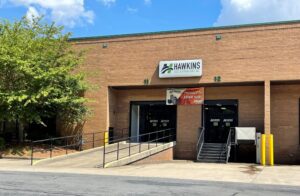Hawkins HVAC Distributors Inc., a regional, family-operated company launched less than six years ago, has set out on a course to expand its business by upgrading how it interacts with and serves its dealer network.

Melanie Cochran, vice president, Hawkins HVAC Distributors Inc.
And in an uncommon approach in its industry, it’s stepping up its digital ecommerce technology and operations to implement that growth strategy.
“In general, HVAC is a little behind the curve in digital transformation,” says Melanie Cochran, vice president of operations, whose family has roots going back decades in the HVAC industry.
The industry is not without ecommerce expertise, as shown by Watsco Inc., a multibillion-dollar national distributor that for years has racked up steady ecommerce sales at a high percentage of its total revenue. But for legions of smaller HVAC distributors that serve local or regional markets, ecommerce is still an opportunity to explore, Cochran says.
In her company’s core market of North and South Carolina and parts of Georgia, she adds, Hawkins is determined to stand out with a digital commerce strategy that complements the Charlotte, North Carolina-based distributor’s industry experience to bring exceptional value in the buying experience to its dealer network, she says.
“We know our industry is lagging in ecommerce, but we know it’s going to come on, and we want to be part of that,” Cochran says. “We want to be a leader of that change.”
Taking that leading ecommerce position rides on how well Hawkins convinces many of its customers to get on board with online purchasing — and on how well it upgrades the online customer buying experience on HawkinsHVAC.com to win over those customers.
Hawkins is off to a promising start as it sets up long-term growth online.
Relaunching a more personalized ecommerce site
The company relaunched its website, at HawkinsHVAC.com, in the fall of 2021, replacing a legacy site with a new level of personalized content and an online buying experience that Hawkins figures it needs to engage online customers.

Hawkins HVAC Distributors’ Charlotte, North Carolina, corporate office.
The privately held company doesn’t publicize sales figures. But Cochran notes that, after launching the new site at the tail end of that year’s peak selling season with 5,000 available SKUs, Hawkins quickly got to 7% to 8% of total sales online, with an average order value of over $1,400 for a mix of HVAC equipment, replacement parts, and supplies.
“For the first year, that was pretty strong for us,” Cochran says.
More significant, however, is that most of the buyers placing the online orders are from Hawkins’s largest customers — a market segment where the distributor is planning on strong sales growth over the long term.
Cochran notes that her company’s ecommerce volume continues to increase, and, over the longer term, Hawkins expects ecommerce to account for about 25% of sales. “Ecommerce is not a huge channel yet for us, but we expect it to be,” she says.
To drive growth, Hawkins has deployed a digital commerce technology platform offering multiple improvements over the prior website, including:
- Product catalogs offering personalized product pricing and selection for each dealer.
- Letting dealers search on multiple product attributes to find exactly what they need.
- Enabling dealers to find the nearest Hawkins distribution branch location when they want to pick up products.
- Educational online content designed to help buyers determine which products suit their job site needs.
- The ability to more easily build new customer-serving features.
Hawkins is operating its new ecommerce system on Amla Commerce Inc.’s Znode headless commerce technology platform, which uses an extensive system of APIs (application programming interfaces) to share data between three independent components: the customer-facing online interface, the ecommerce engine, and the enterprise resource planning system. Hawkins retained Xngage, a B2B digital commerce services firm, to implement the Znode platform and integrate it with the distributor’s related technology systems.
In addition to the Znode ecommerce platform and customer-facing website, Hawkins’s digital technology infrastructure includes:
- Infor CloudSuite Distribution enterprise resource planning software.
- AD product information management (PIM), from the AD (Affiliated Distributors) distributors’ organization, as well as a built-in Znode PIM.
- Billtrust invoice management, which lets HVAC dealers on HawkinsHVAC.com link to Billtrust to view and manage their Hawkins invoices.
The new platform, Cochran says, was a good fit to integrate with the distribution company’s digital technology ecosystem, helping to provide the kind of personalized buying experience its dealers want. For example, the API-driven headless configuration enables Hawkins to modify the customer-facing interface without also having to redo the software in the ecommerce engine or the back-end business operations software in the ERP system.
At first, Hawkins was wary of relying on APIs
The commerce platform uses APIs to transfer information between the Infor ERP, the AD PIM (which uses EnterWorks PIM software) and the Znode ecommerce platform, providing ecommerce customers with such information as up-to-date product descriptions, the location of available inventory by distribution center, and order status.
At first, Hawkins was wary of going with a new ecommerce platform that relied heavily on APIs, as is the case with Znode.
“We were nervous about that because with our original ecommerce platform, one of the main issues we had was speed and lag time,” Cochran says, adding, “The folks we were using at the time were blaming that [slow] speed on APIs, so we were nervous about having another system that was built off of APIs.”
But she adds that Znode, which Hawkins came to know through Xngage and AD, has so far proved to be an effective platform for building digital commerce. AD is an organization that serves as a buying group for its membership of independent distributors.
Quick-order forms and online inventory management
In addition to providing personalized product catalogs and pricing, Hawkins is also developing online features and promotions to improve the online buying experience and generate more sales. For example, returning customers can use a quick-order feature to reorder parts by simply inserting the Hawkins part identification numbers and the needed quantity, then clicking Add to Cart.
When one new large customer wanted to start placing orders with its own system of parts numbers, Hawkins was able customize its product data management to accommodate the customer.
“So that customer can log onto our website and not only see their pricing and our inventory levels, but they can also search for products with the numbers they already know,” Cochran says.
Going forward, she adds, Hawkins will look into further adding to its customers’ online buying experience, features that would appeal to large customers in a market extending far beyond its current base in the Carolinas.
Building an ecommerce-based replenishment system
One project on the drawing boards is building an ecommerce-based system to replenish the HVAC parts and supplies inventory that dealers keep on their service trucks and in storerooms. By scanning products as they use them on customer service calls, dealers and their technicians will be able to trigger online orders to maintain a minimum level of on-hand inventory. Another version of this replenishment system would let dealers review their updated on-hand inventory status at the end of each day or week, then click to place an order based on that status plus any additional products they need to satisfy large orders known to be coming in from dealers.
In addition, the internet-based electronic inventory management system would also track parts and supplies usage by individual technicians, helping contractors to better control inventory and view the performance of individual workers, Cochran says.
Such reordering and inventory-management and -visibility features may be common among large B2B companies in industries such as maintenance, repair and operations (MRO) products. Among HVAC distributors, however, it’s far from a common strategy, she says.
But that void presents an opportunity for Hawkins to stand out.
“One of our goals is really to just be innovative in this industry,” Cochran says.
Sign up
Sign up for a complimentary subscription to Digital Commerce 360 B2B News, published 4x/week. It covers technology and business trends in the growing B2B ecommerce industry. Contact editor Paul Demery at [email protected] and follow him on Twitter @pdemery.
Follow us on LinkedIn and be the first to know when we publish new Digital Commerce 360 B2B News content.
Favorite